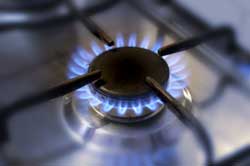
In a year of high heating bills, finding ways to save energy can really add up to big savings. Because the kitchen is usually one the busiest rooms in the home, it is also one of the rooms that uses the most energy. Follow these simple, inexpensive tips to shave a few dollars off your energy bill.
The Oven and Stove
Energy (fuel) costs from cooking can run from $50-$100 per year. Over time, a few simple changes can add up to big savings.
Clean the reflectors under the burners to reflect heat more efficiently.
Gas burners should be cleaned on a regular basis to keep food and grease from clogging ports. When free of clogs, flames will be blue and even. A yellow flame suggests the port needs to be cleaned or adjusted. The tip of the flame (hottest part) should reach the bottom of the pan.
Food cooked in ceramic or glass pans and dishes will cook at lower temperatures than those cooked in metal.
Avoid "peeking" into the oven to check on baking progress. Each time you open the door, you lose 25% of the heat.
Turn off burners during the last few minutes of cooking. The remaining heat will be enough to finishing the cooking.
Match the pot to the burner. Heat and energy are lost if the burner is bigger than the size of the pot.
If you're considering a new cook top, induction cook tops are the most efficient users of energy. They use up to 90% of the energy they produce (electric burners use about 65% and gas burners use 55%).
The Refrigerator
Believe it or not, your refrigerator can be the third largest contributor to your total energy bill. When it's time to decide whether to repair an older model, it would be wiser to invest the money into a new, more energy efficient model; you'll see an instant $75-$100 savings on your yearly electric bill. In the meantime, try these tips.
To keep your refrigerator running at peak efficiency, keep the coils on the back and bottom clean and cool. This means routine vacuuming of the condensing coils and keeping them away from external heat sources like stoves, radiators and heat vents. Leave enough space between the coils and the wall for cooling air circulate around the condensing coils.
Give gaskets the dollar bill test. Close the door on one half of a dollar bill. If it pulls out easily when tugging on it, your not getting a good seal and your gaskets may need replacing or adjusting.
Your refrigerator and freezer will perform better if kept relatively full. Make sure food items are spaced a little apart to allow air to circulate around them.
Keep temperature settings between 38ºF and 40º F in the refrigerator, and 5ºF in the freezer (stand alone freezers should be kept at 0ºF).
Keep humidity down by keeping liquids covered and make sure hot foods are allowed time to cool before storing.
The Garbage Disposal
Running cold water while operating your garbage disposal will save energy on water heating. Use hot water only when necessary to wash away small amounts of grease.
The Dishwasher
If your dishwasher has an automatic air-dry setting, turn it off. Letting dishes air dry by opening the door can reduce a dishwasher's energy use by half. Use a good quality dishwasher detergent to prevent spots.
Pre-rinse your dishes (using cold water) before loading the dishwasher and only run when you have a full load. Run you dishwasher in the energy savings mode if you have one, and use cold water for the rinse cycle.
The Water Faucet
If you have a leaky faucet, fix it. It can usually be done for the price of a couple of washers, but a slow drip (especially hot water) can cost $35-$40 per year.
Consider attaching a low-flow aerator to your kitchen faucet. They reduce the amount of water you use without producing a noticeable difference in water flow. They are easy to install, cost from $1 to $5 dollars and will help lower your water bill and water heating costs.
The Microwave
Microwaves use as little as half the amount of energy of a conventional oven, so use them in place of conventional stoves and ovens whenever possible. Other advantages include the fact that they produce less of a build up of radiant heat in the kitchen during warm weather and they provide the most efficient means of reheating, cooking small portions and defrosting food.
Other Appliances
Turn off and unplug appliances when not in use or when you're planning on being away from home for a few days.
As old appliances wear out or break down, replace them with energy efficient models like Energy Star® appliances.
Task Lighting
Utilize task lighting in the kitchen whenever possible and replace burned out bulbs with energy efficient compact fluorescent light bulbs.

About The Author: Ellen Brown is our Green Living and Gardening Expert. Click here to ask Ellen a question! Ellen Brown is an environmental writer and photographer and the owner of Sustainable Media, an environmental media company that specializes in helping businesses and organizations promote eco-friendly products and services. Contact her on the web at http://www.sustainable-media.com
Add your voice! Click below to comment. ThriftyFun is powered by your wisdom!
My trick is to never cook one casserole at a time. The other pops into the fridge or freezer when I need a quick meal just defrost and reheat.
cj in dallas
Whenever I can, I use the microwave or my crockpot for cooking at least a portion of the meal. Often, you can microwave for part of the time, then switch the food to the stovetop or the oven. For things like pizza rolls, egg rolls, etc, I use the toaster oven so I don't have to heat a big oven just to make these. The microwave and the toaster oven are also easy for my children to use.

After I'm done using my oven and have turned it off, I leave the oven door fully open to help warm my kitchen in winter months. Some of that warm air drifts to other rooms on the main floor of my house.
By truerblue
Editor's Note: If you have curious pets or little children, you will just want to open the door a little ways.

Use a toaster oven or small electric pans for your small meals rather than a large oven or stove. A toaster oven uses 1/3 to 1/2 as much energy as a full sized oven. Microwave ovens and pressure cookers reduce cooking time, as well. Using a lid with a pan uses less energy.
By Terri H.
Unplug those kitchen appliances that you're not using, at that time (ex: blender, electric can opener, toaster). Only plug in when you're going to use it, unplug after you're finished.

A full freezer keeps warm air out when you open the door. Get everything you need out of the refrigerator or freezer at one time to keep cool air from escaping.
By T.H.

By Lillian & Dave Brummet
The kitchen, with all its appliances, gadgets and heat, is a real hotspot for potential energy saving. As the oven uses the most energy and creates a vast amount of heat while cooking foods, it is a good place to start.
For instance, when baking cookies use two trays. While one is in the oven baking, the other one is prepped with raw cookies - ready to replace the tray in the oven with no wasted heat and some time saved.
When we bake bread we also fill the oven with foil wrapped potatoes. The potatoes can be stored in the fridge without the foil and used throughout the week in a myriad of recipes, or as a side dish. This method can be applied to a menu plan in that if you are baking one dish, try to include a side dish that is baked as well.
By turning off the oven a minute or two before the dish is done, the residual heat will finish the cooking.
When done with the oven, open the door to allow any leftover heat to warm the home.
Pasta cooking water can be left out until it has completely cooled - so that the heat and moisture are released back into the air.
Before pulling the plug, consider leaving hot dishwater (and bath water) until it cools. Why pay to heat up your sewer pipes?
When cooking vegetables, consider steaming instead of boiling. When steamed, more nutrients are retained in the food, and because it requires less water to heat - there is less energy used.
In summer, consider cooking on the barbecue to help keep the house cool. Most barbecues now include side burners that make outdoor cooking all that much easier.
All these methods are relatively easy to adopt and when added up, the savings in energy and time really do make a difference.
About The Author:
Written by Dave and Lillian Brummet based on the concept of their book, Trash Talk. The book offers useful solutions for the individual to reduce waste and better manage resources. A guide for anyone concerned about his or her impact on the environment. (www.sunshinecable.com/
A shiny new glasstop stove came with my new house, and I HATE it. It's impossible to maintain a steady level of heat, the top stays hot far too long after it's turned off, and it takes twice as long to heat up as I'm used to. Chinese style stir frying is a thing of the past, thanks to this monstrosity. Before anyone allows themselves to be talked into this "glass elephant", PLEASE assess your cooking style, and look into the things this style stove will NOT do. Yes, it saves a little money over the course of a year. Is it worth it to Me? HECK no! (& I don't mean 'heck', if 'ya know what I mean
Use saucepan lids, water boils a lot faster, using less heat...
I have heard people say to unplug small appliances so that they don't continue to use electricity. I was wondering if there is any truth to this.
Add your voice! Click below to comment. ThriftyFun is powered by your wisdom!